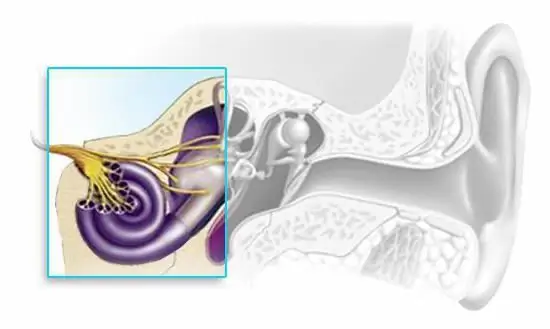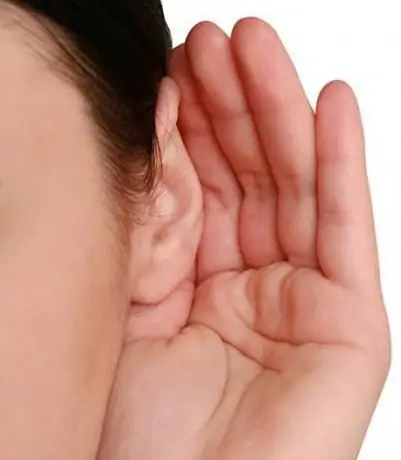- Author Curtis Blomfield [email protected].
- Public 2023-12-16 20:44.
- Last modified 2025-01-23 17:01.
In modern medical practice, such a problem as sensorineural hearing loss is quite common. This disease is associated with a gradual hearing loss. According to statistics, the number of patients with a similar diagnosis has increased significantly in recent years. That is why information about the main causes and signs of the disease will be useful to many readers.
What is a disease?

Sensorineural hearing loss is a disease that is associated with a general hearing loss, the cause of which may be damage to the inner ear (the organ of Corti, which turns vibrations into electrical impulses transmitted to the nerve endings), the auditory nerve, or the auditory centers in the brain.
Degrees of sensorineural hearing loss can vary, ranging from a slight decrease in sensitivity to sound to complete deafness. According to statistics, about 400 million people in the world todayday suffer from this pathology, and the number of registered cases of the disease is growing every year. Most often, the victims of the disease are young or mature able-bodied people. So what are the causes of its development and what are the first symptoms?
Forms and schemes of disease classification

Today, there are many classification systems for this disease. For example, sensorineural hearing loss can be divided into congenital and acquired. In turn, congenital pathology happens:
- non-syndromic (the disease is accompanied only by hearing loss; this form is diagnosed in 70-80%);
- syndromic, when, along with hearing loss, the development of other diseases is observed (an example is Pender's syndrome, in which a violation of sound perception is associated with a simultaneous functional change in the functioning of the thyroid gland).
Depending on the clinical picture and the rate of progression of the disease, it is customary to distinguish three main forms, namely:
- Sudden (rapid) form of the development of the disease, in which the pathological process is formed very quickly - the patient partially or completely loses hearing within 12-20 hours after the onset of the first symptoms. By the way, timely treatment, as a rule, helps to restore the functioning of a person's hearing aid.
- Acute hearing loss - does not develop so quickly. As a rule, there is an increase in symptoms that lasts about 10days. It is worth noting that many patients try to ignore the problem, attributing ear congestion and hearing loss to fatigue, wax buildup, etc., postponing a visit to the doctor. This negatively affects the state of he alth, while immediately started therapy increases the chances of successful treatment several times.
- Chronic sensorineural hearing loss is perhaps the most complex and dangerous form of the disease. Its course is slow and sluggish, sometimes patients live with the disease for years, not even knowing about its presence. Hearing may decline over the years until constant, annoying tinnitus causes a visit to a doctor. This form is much more difficult to treat with medication, and quite often it is not possible to restore hearing. In some cases, this pathology leads to disability.
There are other classification systems. For example, hearing loss can be either unilateral (affecting only one ear) or bilateral, and can develop both in infancy (even before the child learns to speak) and in adulthood.
Degrees of sensorineural hearing loss

Today, it is customary to distinguish four degrees of disease progression:
- Sensoneural hearing loss of the 1st degree - accompanied by a decrease in the threshold of sensitivity to 26-40 dB. At the same time, a person can distinguish sounds at a distance of 6 meters, and a whisper - no more than three meters.
- Sensoneural hearing loss 2 degrees - in such cases, auditorythe patient's threshold is 41-55 dB, he can hear at a distance of no more than 4 meters. Difficulties with hearing sound can occur even in calm, quiet environments.
- The third degree of the disease is characterized by a sound threshold of 56-70 dB - a person can distinguish normal speech at a distance of no more than a meter, and not in a noisy place.
- The threshold for sound perception at the fourth stage is 71-90 dB - these are serious disorders, sometimes up to complete deafness.
Main causes of disease development

In fact, there are many factors that can cause sensorineural hearing loss. The most common include:
- frequent infectious diseases, in particular otitis media, influenza and other colds that can cause complications;
- vascular thrombosis;
- inflammatory diseases such as adenoiditis, labyrinthitis, meningitis;
- otosclerosis;
- progressive atherosclerosis;
- acoustic injury;
- traumatic brain injury;
- autoimmune diseases;
- tumor between cerebellum and pons;
- use of certain drugs, in particular salicylates, aminoglycosides;
- damage to the auditory nerve or inner ear by chemicals, toxins;
- work in a noisy factory;
- constant listening to loud music;
- according to statistical studies, residents of large cities often suffer from such a diseasemetropolitan areas.
Sensoneural hearing loss in children: congenital causes
The causes of acquired hearing loss have been described above. However, some children suffer from a similar disease almost from birth. So what are the causes of the development of the disease? There are quite a few:
- genetic inheritance (it is believed that almost 50% of the world's inhabitants are carriers of genes of one form or another of hearing loss);
- congenital aplasia of the cochlea or other anatomical abnormalities;
- intrauterine infection of the fetus with rubella virus;
- presence of alcohol syndrome in a pregnant woman;
- drug use by mother;
- this disorder may be a complication of syphilis;
- Risk factors include early birth;
- sometimes hearing loss develops as a result of a baby being infected with chlamydia during childbirth.
What are the symptoms of the disease?
As already noted, the clinical picture may be different depending on the rate of progression of hearing loss. As a rule, tinnitus appears first, and distortion of sounds is also possible. For example, some patients complain that all sounds are perceived as if they were lowered.
Hearing loss develops gradually. People have trouble hearing sound in noisy environments or crowded groups. As the disease progresses, telephone communication problems arise. When talking to a person, the patient, as a rule, begins to unconsciously follow the movement of the lips, as this helpsdistinguish sounds. Patients constantly ask for words again. As the disease progresses, the problems become more pronounced - if the patient is not treated, the consequences can be sad.
Basic diagnostic methods

Hearing loss is an extremely serious problem, so if you have any symptoms, you should immediately consult a doctor. Diagnosis in this case is a complex process that begins with an examination by an ENT doctor. If during the examination it was possible to reveal that hearing loss is in no way connected with the structure and functions of the outer ear, then other studies are carried out, in particular, tone threshold audiometry, tuning fork tests, impedancemetry, otoacoustic emission, and some others. As a rule, in the process of diagnosis, specialists manage to find out not only the presence of a developing pathology, but also the causes of its occurrence.
Sensoneural hearing loss treatment

Immediately it should be said that self-treatment in this case is unacceptable. The treatment regimen is selected by the attending physician after a thorough diagnosis. So what to do with a diagnosis of sensorineural hearing loss?
Treatment of the acute form of the disease can be medical and depends on the reasons for its development. For example, if there is an infection, anti-inflammatory, antiviral, or antibacterial drugs are prescribed. Additionally, they can prescribe vitamins of group B, as well as E. In the presence of severe edema, diuretics and hormonal drugs are used.
When is prosthetics necessary?
Alas, sensorineural hearing loss can not always be cured with the help of conservative medicine methods. And if the acute form of the disease responds well to drug treatment, then with chronic hearing loss such methods are unlikely to have an effect.

In some cases, the only way to restore a person's hearing is to use a hearing aid. By the way, modern models are small in size and have high sensitivity, which makes them easy to use.
Thanks to the achievements of modern otosurgery, in some forms of the disease, the so-called cochlear implantation is possible, which involves placing special electrodes in the inner ear that can stimulate the auditory nerve. This technique is used only if the hearing loss is associated precisely with a malfunction of the organ of Corti, but the auditory nerve and brain centers are working normally.






